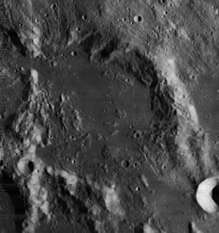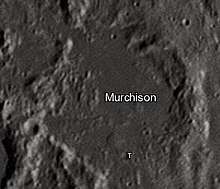Murchison (crater)
Murchison is a lunar impact crater on the north edge of the Sinus Medii. It was named in honour of the geologist Sir Roderick Murchison.[1] It shares a section of rim with the crater Pallas. To the southeast on the mare is the circular crater Chladni, and to the northeast is Ukert. Farther to the east is the prominent Triesnecker. Murchison lies astride the lunar zenith line, i.e. the starting longitude of the selenographic coordinate system.
 Lunar Orbiter 4 image | |
| Coordinates | 5.1°N 0.1°W |
|---|---|
| Diameter | 58 km |
| Depth | 1.8 km |
| Colongitude | 0° at sunrise |
| Eponym | Roderick I. Murchison |

The wall of Murchison is heavily worn and has completely disappeared in a wide gap to the southeast. The rim is most intact along the northeast part of the crater, but even there it is indented and irregular. Only a ridge remains of the rim shared by Pallas and Murchison, with gaps to the north and south. A low ridge from the east wall runs south to join the rim of Chladni. The crater floor has been flooded with lava and joins the Sinus Medii through the wide gap in the southeast wall.
Satellite craters

By convention, these features are identified on lunar maps by placing the letter on the side of the crater midpoint that is closest to Murchison.
| Murchison | Latitude | Longitude | Diameter |
|---|---|---|---|
| T | 4.4° N | 0.1° E | 3 km |
References
- "Murchison (crater)". Gazetteer of Planetary Nomenclature. USGS Astrogeology Research Program.
- Andersson, L. E.; Whitaker, E. A. (1982). NASA Catalogue of Lunar Nomenclature. NASA RP-1097.CS1 maint: ref=harv (link)
- Bussey, B.; Spudis, P. (2004). The Clementine Atlas of the Moon. New York: Cambridge University Press. ISBN 978-0-521-81528-4.CS1 maint: ref=harv (link)
- Cocks, Elijah E.; Cocks, Josiah C. (1995). Who's Who on the Moon: A Biographical Dictionary of Lunar Nomenclature. Tudor Publishers. ISBN 978-0-936389-27-1.CS1 maint: ref=harv (link)
- McDowell, Jonathan (July 15, 2007). "Lunar Nomenclature". Jonathan's Space Report. Retrieved 2007-10-24.CS1 maint: ref=harv (link)
- Menzel, D. H.; Minnaert, M.; Levin, B.; Dollfus, A.; Bell, B. (1971). "Report on Lunar Nomenclature by the Working Group of Commission 17 of the IAU". Space Science Reviews. 12 (2): 136–186. Bibcode:1971SSRv...12..136M. doi:10.1007/BF00171763.CS1 maint: ref=harv (link)
- Moore, Patrick (2001). On the Moon. Sterling Publishing Co. ISBN 978-0-304-35469-6.CS1 maint: ref=harv (link)
- Price, Fred W. (1988). The Moon Observer's Handbook. Cambridge University Press. ISBN 978-0-521-33500-3.CS1 maint: ref=harv (link)
- Rükl, Antonín (1990). Atlas of the Moon. Kalmbach Books. ISBN 978-0-913135-17-4.CS1 maint: ref=harv (link)
- Webb, Rev. T. W. (1962). Celestial Objects for Common Telescopes (6th revised ed.). Dover. ISBN 978-0-486-20917-3.CS1 maint: ref=harv (link)
- Whitaker, Ewen A. (1999). Mapping and Naming the Moon. Cambridge University Press. ISBN 978-0-521-62248-6.CS1 maint: ref=harv (link)
- Wlasuk, Peter T. (2000). Observing the Moon. Springer. ISBN 978-1-85233-193-1.CS1 maint: ref=harv (link)
External links
| Wikimedia Commons has media related to Murchison (crater). |
- Murchison at The Moon Wiki
- Intricate Young Ejecta Blanket in Ancient Murchison
- Wood, Chuck (November 2, 2006). "Move Over Orbiter". Lunar Photo of the Day. Archived from the original on June 14, 2011.
- Wood, Chuck (April 8, 2010). "Textured Ejecta". Lunar Photo of the Day. - Rima Bode, also includes Murchison Crater